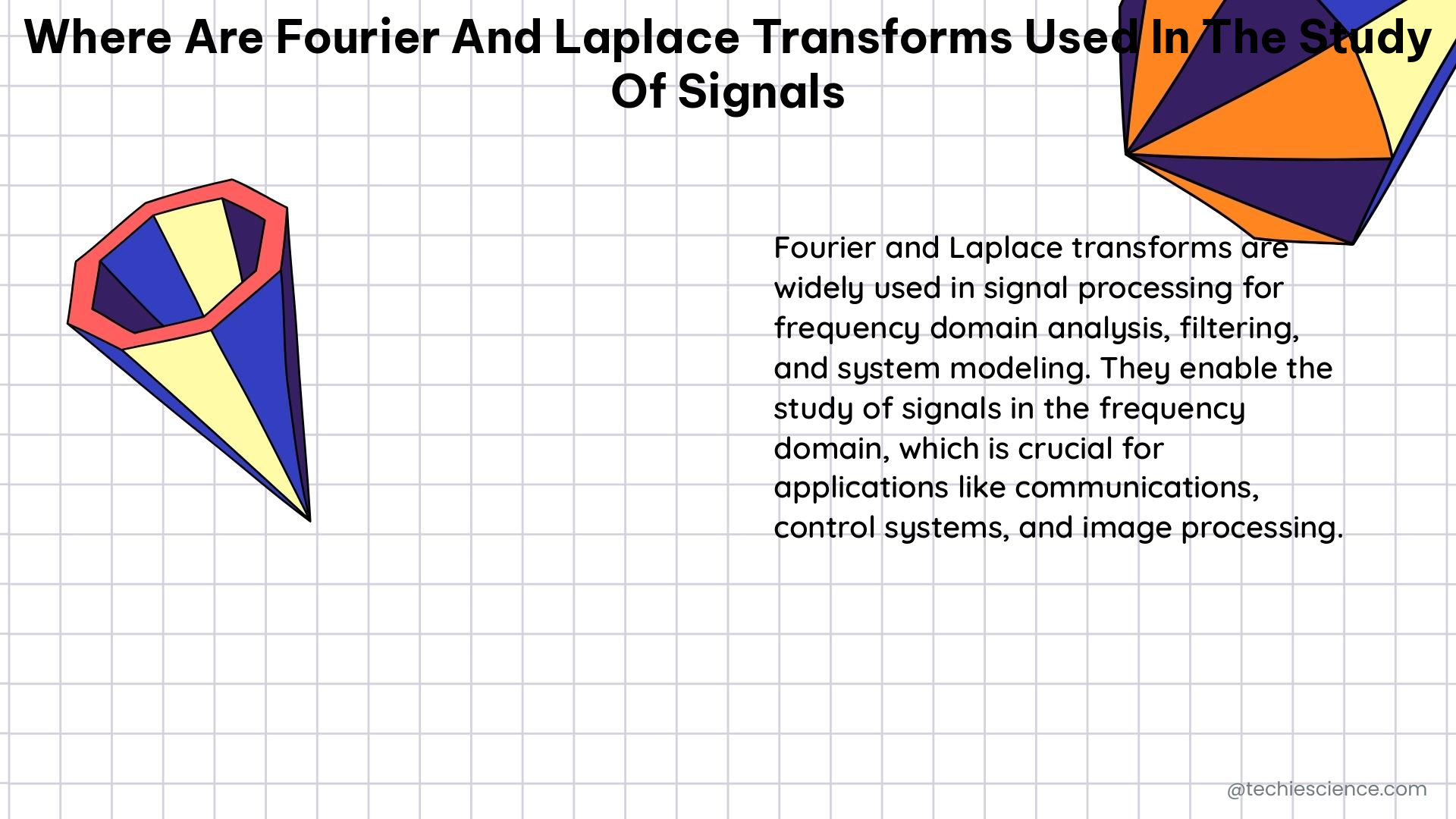Fourier and Laplace transforms are powerful mathematical tools that play a crucial role in the analysis and understanding of signals in various fields of engineering and science. These transforms allow us to study the frequency domain representation of signals, which is essential for a wide range of applications, from signal processing and communication systems to control theory and electrical engineering.
Fourier Transform: Analyzing Stable Signals
The Fourier transform is primarily used to analyze stable signals, where the signal does not exhibit exponential growth or decay over time. This transform represents a function as a continuous sum of exponential functions of the form e^(jωt), where ω represents the angular frequency.
The key applications of the Fourier transform in the study of signals include:
-
Signal Processing: The Fourier transform is extensively used in signal processing to analyze the frequency content of signals. This information is crucial for designing filters, equalizers, and other signal processing components. For example, in audio processing, the Fourier transform is used to identify the frequency components of a sound wave, which is essential for tasks like noise reduction, audio compression, and audio enhancement.
-
Communication Systems: In communication systems, the Fourier transform is used to analyze the frequency spectrum of modulated signals, which is crucial for efficient signal transmission and reception. It helps in the design of transmitters, receivers, and other communication system components.
-
Image Processing: The Fourier transform is also used in image processing, where it is employed to analyze the frequency content of images. This information is useful for tasks like image enhancement, image compression, and image filtering.
-
Vibration Analysis: In the field of mechanical engineering, the Fourier transform is used to analyze the vibration patterns of mechanical systems, which is essential for predictive maintenance and condition monitoring.
The Fourier transform is well-suited for analyzing stable signals because it assumes that the signal is defined for all real numbers, which is the case for many practical signals. However, the Fourier transform may not be suitable for analyzing signals that exhibit exponential growth or decay, as it may not converge in such cases.
Laplace Transform: Analyzing Stable and Unstable Signals

The Laplace transform, on the other hand, is more versatile and can be used to analyze both stable and unstable signals. This transform represents a function as a continuous sum of complex exponential damped waves of the form e^(st), where s is a complex variable.
The key applications of the Laplace transform in the study of signals include:
-
Control Systems: The Laplace transform is extensively used in control systems analysis and design. It allows for the analysis of the stability and transient response of feedback control systems, which may exhibit both stable and unstable behavior.
-
Electrical Circuit Analysis: In electrical engineering, the Laplace transform is used to analyze the behavior of electrical circuits, including both stable and unstable components. It is particularly useful for solving differential equations that describe the behavior of electrical circuits.
-
Differential Equation Solving: The Laplace transform is a powerful tool for solving linear, time-invariant differential equations, which are commonly encountered in various engineering and scientific applications. The Laplace transform can be used to convert a differential equation into an algebraic equation, which can then be solved more easily.
-
Signal Processing: While the Fourier transform is more commonly used in signal processing, the Laplace transform can also be employed in certain applications, particularly when dealing with signals that exhibit exponential growth or decay.
The Laplace transform is more general than the Fourier transform because it includes a convergence factor, which allows it to handle signals that are not absolutely integrable. This makes the Laplace transform particularly useful for analyzing unstable systems, where the Fourier transform may not be applicable.
Technical Specifications and Considerations
Both the Fourier and Laplace transforms have specific technical requirements and considerations:
-
Absolute Integrability: Both transforms require that the function being transformed is absolutely integrable, meaning that the integral of the absolute value of the function over all real numbers is finite.
-
Domain of Definition: The Fourier transform is defined for functions that are defined for all real numbers, while the Laplace transform does not require that the function is defined for a set of negative real numbers.
-
Convergence: The Laplace transform is more general than the Fourier transform due to the convergence factor, which allows it to handle signals that are not absolutely integrable.
-
Differential Equations: The Laplace transform is widely used for solving linear, time-invariant differential equations, as it can convert the differential equation into an algebraic equation that can be more easily solved.
-
Frequency Domain vs. s-Domain: The Fourier transform converts a time-domain function into a frequency-domain function, while the Laplace transform converts a time-domain function into an s-domain function, which includes both the frequency and the damping factor.
In summary, the Fourier transform is primarily used in signal processing and communication systems, where signals are often stable and do not exhibit exponential growth or decay. The Laplace transform, on the other hand, is more widely used in control systems and electrical engineering, where systems may be unstable and require analysis of both stable and unstable responses.
References:
- When to use Laplace vs Fourier Transform
- Relation between Laplace and Fourier Transforms
- Difference between Laplace Transform and Fourier Transform
- Fourier vs Laplace Transforms

The lambdageeks.com Core SME Team is a group of experienced subject matter experts from diverse scientific and technical fields including Physics, Chemistry, Technology,Electronics & Electrical Engineering, Automotive, Mechanical Engineering. Our team collaborates to create high-quality, well-researched articles on a wide range of science and technology topics for the lambdageeks.com website.
All Our Senior SME are having more than 7 Years of experience in the respective fields . They are either Working Industry Professionals or assocaited With different Universities. Refer Our Authors Page to get to know About our Core SMEs.